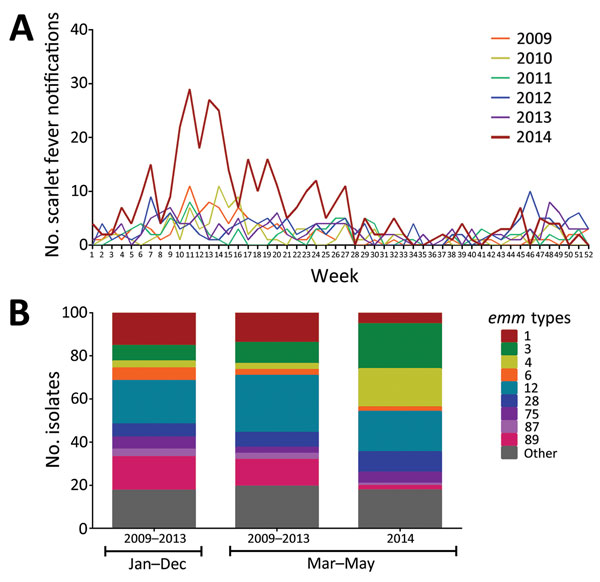Volume 22, Number 6—June 2016
Dispatch
Scarlet Fever Upsurge in England and Molecular-Genetic Analysis in North-West London, 2014
Figure

Figure. Increase in North-West London scarlet fever notifications and association with emm4 and emm3, 2014. A) Weekly scarlet fever notifications in North-West London during 2009–2014. During weeks 10–20 (March–May) 2014, the number of notifications substantially increased. B) emm genotyping of 404 upper respiratory tract Streptococcus pyogenes isolates. Isolates were available from March 2009 through May 2014, inclusive. A total of 308 isolates were from 2009–2013; however, of these, 134 were from 2009, and 174 were from 2010–2013, reflecting a fall in submission rates and affecting the availability of strains for study. Thus, isolates from 2009–2013 were considered a single group (January–December) and the following emm-types were identified: emm12 20% (62/308), emm89 16% (48/308), emm1 15% (47/308), emm3 7% (22/308), emm28 6% (19/308), emm4 3% (10/308). A similar pattern was observed during March–May in 2009–2013 (n = 72). A total 96 isolates were available from 2014, all of which were from March–May, submitted following alerts to clinicians regarding scarlet fever activity. During March–May 2014, isolates typed as emm4 increased significantly, from 3% (2/72) to 17% (17/96), (χ2(1df) = 9.478. p = 0.0021). A borderline significant increase occurred in emm3, from 10% (7/72) in 2009–2013 to 20% (20/96) in 2014 (χ2(1df) = 3.766, p = 0.0523). This constituted a 3-fold increase in emm3 and emm4 combined, from 13% in 2009–2013 to 37% in 2014 (March–May).
1Current affiliation: Royal Sussex County Hospital, Brighton, UK.